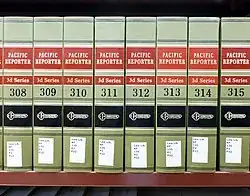For those not familiar with it, a "reporter" is a periodical publication that prints of full text of published decisions of the courts covered by the reporter (historically, a task mostly done by commercial publishing firms such as the firm branded as "West" which hasn't been anything more than a brand since it was acquired by another firm, for a long time).
This would be done in encyclopedia sized bound volumes, often numbering in the hundreds, and the citation was to volume X on page Y of the reporter.
So, if something were in volume 348 of the Pacific Reporter on starting on page 24, the case number would be 348 P. 24.
In this system if you want to refer to a specific quotation or point within a case, you add a "pinpoint citation" to the page upon which what you are referring to is located, so for example, a full citation with pinpoint citation might read:
The court of appeals found that the issue of estoppel was not
preserved in the trial court. Jones v. Doe, 348 P. 24, 33 (Colo.
App. 1984).
This full citation contains the surnames of first parties in the case as Plaintiff and Defendant (preferably underlined or in italics), followed by the case citation, followed by the pinpoint citation followed by a parenthetical with the abbreviation of the court and the year decided). The point referenced is on page 33 of volume 348 of the Pacific reporter as part of a case which starts at page 24 of the same volume.

The courts in recent years became concerned about becoming too reliant upon commercial case reporters run by private businesses for official governmental court business, so they created a "neutral" a.k.a. "public domain" citation system. This also reflected the concern that dead tree book reporters might cease to exist entirely so that the citation system should not be wedded to them.
In this system the format is YEAR abbreviation for the court SEQUENTIAL NUMBER OF CASE IN COURT IN THAT YEAR.
So, for example, 2020 CO 57 is the 57th published cases decided by the Colorado Supreme Court in the year 2020.
In this system if you want to refer to a specific quotation or point within a case, you add a "pinpoint citation" to the paragraph number in which what you are referring to is located, so for example, a full citation with pinpoint citation might read:
The court of appeals found that the issue of estoppel was not
preserved in the trial court. Martin v. Nelson, 2020 CO 57, ¶ 22.
This form of full citation starts with the surnames of first parties listed as plaintiff and defendant in the case, followed by the case citation, followed by the pinpoint citation. The parenthetical found in a reporter based citation is omitted as redundant.
For many years now, however, almost no one has used the physical dead tree bound volumes to research law (a transition that has occurred during my career with the transition taking place around 2005 +/- a few years for the most part), although the volumes and page numbers in physical volumes are still used as one method to identify published decisions in court cases. Neutral citation forms are somewhat more recent than that for the most part.
A quite complete list of abbreviations used in legal citations can be found here. The sidebar at the link further decodes citation practices.
